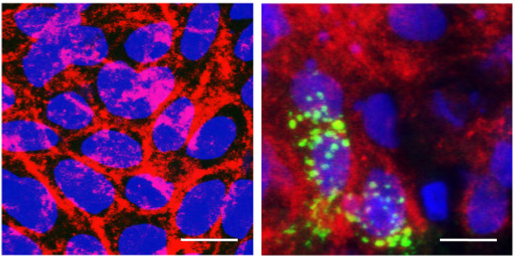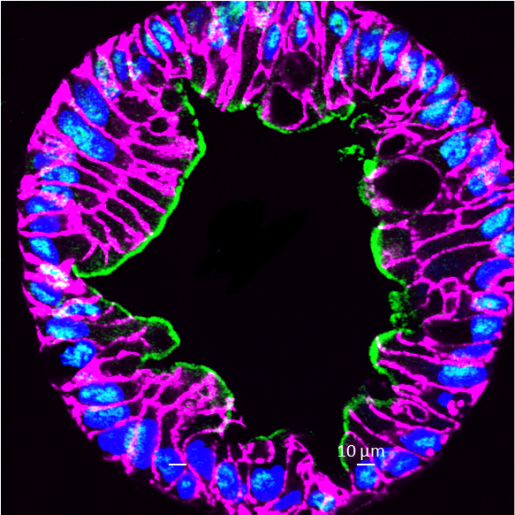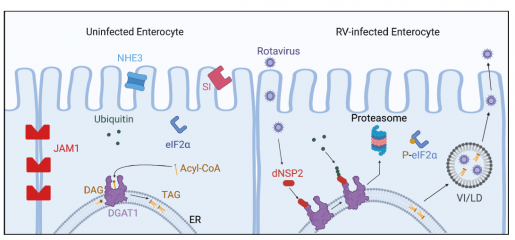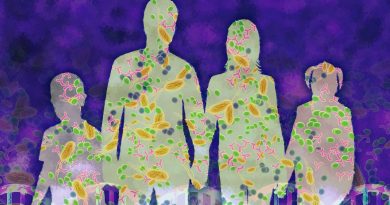Gastrointestinal discomfort? Here is a new explanation for how rotavirus makes you sick
Got a bad case of gastrointestinal discomfort? Rotavirus might be the cause. This virus causes gastroenteritis, a condition that includes diarrhea, deficient nutrient absorption and weight loss. Severe cases result in approximately 128,000 deaths annually in infants and children worldwide.

Despite intense research on how rotavirus causes diarrhea, there is still no complete answer, but in this study published Proceedings of the National Academy of Sciences researchers at Baylor College of Medicine report a new mechanism by which rotavirus induces diarrhea, interfering with the normal absorption of nutrients in the intestine.

“We wanted to better understand how rotavirus exploits cellular processes to replicate,” said co-corresponding author Dr. Sue E. Crawford, assistant professor of molecular virology and microbiology at Baylor. “We used the well-established monkey kidney cell (MA104) model of rotavirus infection as well as human intestinal enteroids (HIEs) for these studies. HIEs have revolutionized the study of gastrointestinal (GI) viruses like rotavirus. These multicellular, non-transformed cell cultures retain host genetic properties, cellular organization and recapitulate the function of the human gastrointestinal epithelium. They serve as biologically relevant model systems for studying human GI infections.”

Crawford and her colleagues knew that rotavirus triggers the formation of more lipid droplets than normal in the cells it infects, as it turns the lipid droplets into virus factories. While they were studying this process, they discovered that rotavirus binds to and breaks down DGAT1, an enzyme that contributes to the formation of the lipid droplets.

As the researchers looked deeper into DGAT1, they discovered that there are children who are born with mutations in the enzyme that render it nonfunctional. “These children have severe chronic diarrhea, which sometimes is fatal,” said co-first author, Hunter Smith, graduate student in Dr. Mary Estes’s and Crawford’s lab at Baylor. “This led us to think that rotavirus-mediated degradation of DGAT1 could be a mechanism by which the virus induces diarrhea.”
It was always thought that the virus caused diarrhea by infecting the intestinal cells that take up nutrients, killing them and consequently disrupting the nutrient absorption mechanisms of the intestine.
But we found a new mechanism by which rotavirus induces diarrhea. Like the children who have a genetic DGAT1 deficiency that causes the condition, when rotavirus breaks down DGAT1 cells reduce the production of enzymes that are involved in degrading the food we eat, disrupting the mechanisms that transport nutrients into cells, which leads to diarrhea,” Smith said.

“It was very unexpected that rotavirus has a protein that interacts with and degrades DGAT1 and that eliminating DGAT1 would lead to all these downstream effects that would cause diarrhea,” Crawford said.

Mutations on DGAT1 in children and the link to diarrhea have been known in the last 10 years. “Before that nobody would have said that there was any association between problems with this enzyme and diarrhea,” said Estes, Distinguished Service Professor of Molecular Virology and Microbiology and Cullen Foundation Endowed Chair at Baylor. She also is a member of Baylor’s Dan L Duncan Comprehensive Cancer Center and co-corresponding author of this work with Crawford.
“It was very surprising that a rotavirus protein that until now was only known to be important for the virus to replicate, also plays a role in causing diarrhea, a major component of the disease,” Estes said.
The fact that it’s not a capsid protein or part of the structure that envelops the genetic material of the virus, as we usually would think, tells us that we should not assume that nonstructural proteins do not play roles in causing disease.”
Co-first author Zheng Liu, Jeanette M. Criglar, Antonio J. Valentin, Umesh Karandikar and Xi-Lei Zeng also contributed to this work. The authors are affiliated with Baylor College of Medicine or Rice University.
This work was supported by National Institutes of Health grants (R01 AI080656, U19 AI116497 and 1S10OD028480), funding from P30 Cancer Center Support Grant (NCI-CA125123), P30 Digestive Disease Center (NIDDK-56338-13/15), CPRIT (RP150578) and the John S. Dunn Gulf Coast Consortium for Chemical Genomics.
Follow From the Labs on X @BCMFromtheLabs and Instagram!



